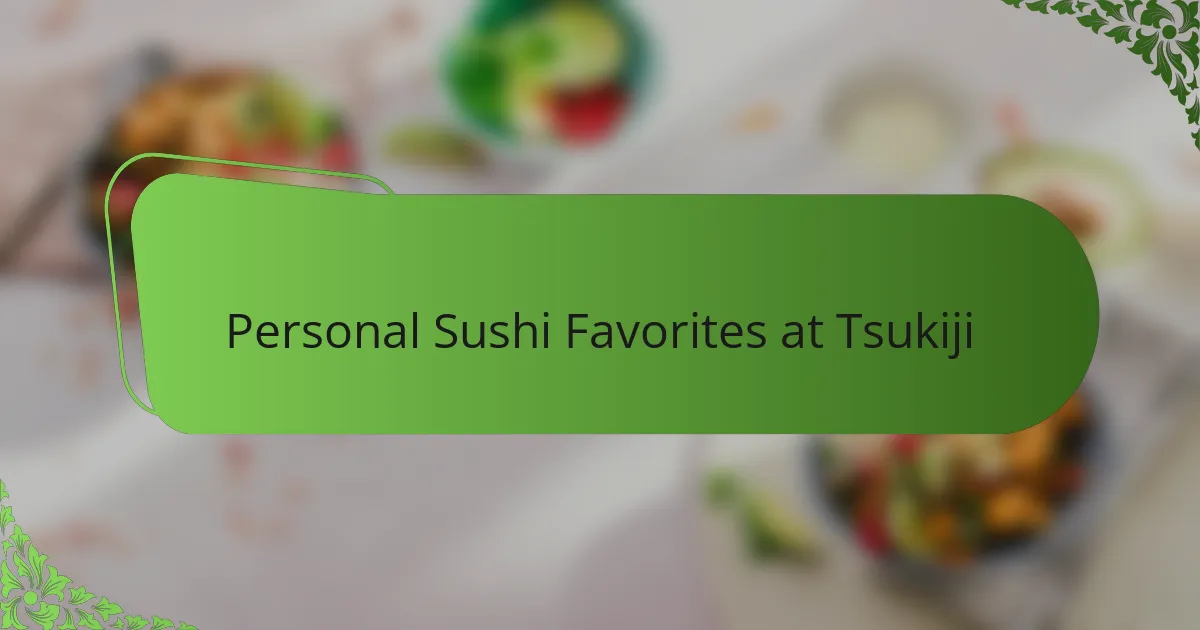Key takeaways
- Tsukiji Fish Market is a dynamic hub for fresh seafood in Tokyo, where each sushi piece reflects the market’s daily bounty and the chefs’ craftsmanship.
- Choosing the best sushi stalls involves observing local crowds, chef techniques, and trusting personal instincts for a more authentic experience.
- To properly taste sushi, savor it in one bite, pay attention to texture, and allow it to warm slightly to unlock its flavors.
- Arrive early, wear comfortable shoes, and engage with vendors for an enriching food experience at Tsukiji Market.

What is Tsukiji Fish Market
Tsukiji Fish Market is more than just a marketplace; it’s a vibrant hub where the freshest seafood in Tokyo comes alive every day. From what I’ve experienced, the energy here is contagious – the chatter of traders, the clatter of crates, and the sheer variety of fish make it feel like a seafood lover’s dream. Have you ever wondered where the best sushi ingredients originate? For me, Tsukiji provided that answer firsthand.

Overview of Sushi at Tsukiji
Sushi at Tsukiji isn’t just about eating; it’s about experiencing freshness in its purest form. I remember biting into a piece of toro there and feeling the rich, buttery texture melt in my mouth—something you rarely find outside such a renowned fish market. Have you ever tasted fish so fresh that it almost transports you?
What sets Tsukiji sushi apart is how each piece tells a story of its origin. The chefs here handle ingredients with profound respect and skill, often serving cuts that embody the market’s daily bounty. It’s like tasting the ocean’s best offerings, crafted by hands deeply connected to this vibrant locale.
From my visits, I’ve noticed that the sushi at Tsukiji balances tradition and spontaneity perfectly. The selection changes with what’s freshest, and every sushi chef seems to have their signature touch. This dynamic nature keeps me coming back, eager to discover new flavors with every visit.

Choosing the Best Sushi Stalls
Choosing the best sushi stalls at Tsukiji can feel overwhelming given the sheer number of options, but my tip is to look for stalls where locals gather and the line moves steadily. When I followed this simple guide, I found the freshest finds and was rewarded with sushi that tasted like it was made just for me. Don’t you think the best spots have that invisible buzz of trust and satisfaction from regulars?
Another trick I’ve learned is to watch how chefs work. The best sushi chefs at Tsukiji move with confidence and care—they treat every piece like a tiny masterpiece. I remember one morning when I saw a chef gently slicing fresh uni with such precision that it made me appreciate the dedication behind each bite before I even tasted it.
Trusting your instincts also plays a big role. Sometimes, I pick a stall simply because it has a warm atmosphere or the chef smiles as they craft each sushi. That personal connection, however brief, always adds to the deliciousness. Have you ever noticed how a friendly vibe can make your meal even better? I certainly have.

How to Taste Sushi Properly
Tasting sushi properly is an art that begins the moment you pick up a piece. I always remind myself to savor it in one bite, allowing the flavors to mingle fully on my palate. Have you ever noticed how breaking sushi into smaller parts can rob you of that perfect balance between rice and fish? I certainly have, and it changes everything.
I’ve found that paying attention to texture reveals so much about sushi’s quality. The subtle resistance of firm fish against the softness of vinegared rice creates a harmony that I find deeply satisfying. Isn’t it amazing how something so simple can offer such a nuanced experience? For me, that contrast is part of what keeps me hooked.
Another trick I swear by is letting the sushi warm just slightly if it feels too cold—this unlocks its natural aromas without losing freshness. When I first tried this, the flavors seemed to open up like a secret waiting to be discovered. Have you ever felt that moment when a piece of sushi suddenly “comes alive” in your mouth? That’s when you know you’re truly tasting it properly.

Personal Sushi Favorites at Tsukiji
One of my absolute favorites at Tsukiji has to be the otoro—the fatty tuna belly. The moment I took my first bite, I was struck by a melt-in-the-mouth richness unlike anything I’d experienced before. Have you ever had a flavor so delicate yet so powerful that it lingers in your memory? That’s exactly how otoro tasted to me there.
Another standout for me is the uni, or sea urchin. I recall nervously ordering it the first time, unsure if I’d like its creamy texture and bold ocean flavor. But with each bite, a buttery sweetness unfolded that felt both luxurious and fresh—like tasting the sea itself in a single mouthful. Isn’t it incredible when something unexpected becomes an instant favorite?
And I can’t forget the anago, or saltwater eel. It’s often overshadowed by more glamorous choices, but at Tsukiji, it was a revelation. The eel was tender and smoky, perfectly balanced by a subtly sweet glaze. I found myself savoring every bite slowly, appreciating how this humble piece captured the essence of the market’s depth and tradition. Have you ever been surprised by a simple dish that completely won your heart? That was my moment with anago.

Tips for Visiting Tsukiji Market
Navigating Tsukiji Market can feel like stepping into a bustling maze, so my first tip is to arrive early—ideally before the crowds swell. I learned this the hard way once; arriving late meant missing out on some of the freshest catches and having to wait in long lines, which dulled the excitement a bit. Have you ever felt that frustration of chasing a fleeting experience? Getting there early lets you soak in the atmosphere while the market is still waking up.
Another thing I’ve found helpful is wearing comfortable shoes. The market covers a sprawling area, and you’ll likely be on your feet for hours, darting between stalls. When I ran around in flip-flops, my feet paid the price by day’s end—lesson learned! Plus, a small backpack to keep your hands free makes tasting and browsing so much easier.
Finally, don’t be shy about asking questions. Vendors and chefs at Tsukiji are often happy to share stories about their fish or recommend dishes, which deepened my appreciation for what I was eating. Have you ever had a local share a secret tip that changed how you experienced a food? Those moments at Tsukiji made the experience far richer than just a meal.

Conclusion and Recommendations
From everything I’ve experienced at Tsukiji, my biggest recommendation is to approach the market with an open mind and a patient spirit. Trust your instincts when choosing stalls, and don’t hesitate to engage with the chefs—they often reveal little stories that turn a simple bite of sushi into a memorable experience. Have you ever felt how a genuine smile or a shared passion makes food taste even better? That’s the magic here.
I also suggest pacing yourself to fully savor each piece. Rushing through the market might mean missing the subtle nuances that make Tsukiji sushi so exceptional—whether it’s the melt-in-the-mouth texture of otoro or the delicate sweetness of fresh uni. From my visits, those moments of slow enjoyment are when the flavors truly come alive.
Lastly, if you plan to visit, I can’t stress enough the value of arriving early and dressing comfortably. The energy in the market at dawn is palpable and the freshest offerings disappear quickly. Experiencing Tsukiji like this transformed my visits into something more than just eating—it became a journey of flavors and stories I cherish. Do you think a place can change how you taste food? For me, Tsukiji definitely does.



